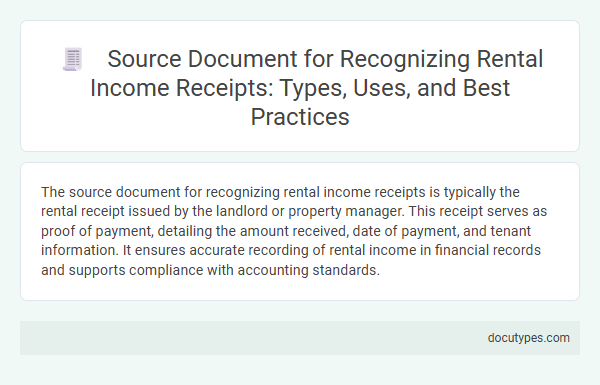The source document for recognizing rental income receipts is typically the rental receipt issued by the landlord or property manager. This receipt serves as proof of payment, detailing the amount received, date of payment, and tenant information. It ensures accurate recording of rental income in financial records and supports compliance with accounting standards.
Introduction to Rental Income Receipts
What is the source document for recognizing rental income receipts? Rental income receipts are primarily recorded from the rental agreement or lease contract signed between the landlord and tenant. These documents validate the payment terms and serve as evidence for booking rental income in accounting records.
Definition and Importance of Source Documents
| Definition of Source Document | A source document is an original record that captures the details of a financial transaction. For recognizing rental income receipts, this typically includes lease agreements, rent payment receipts, bank deposit slips, and tenant payment confirmations. |
|---|---|
| Importance of Source Documents | Source documents serve as the foundational evidence for recording rental income accurately. They ensure transparency, support audit trails, and validate the timing and amount of rental income recognized in accounting records. |
| Role in Rental Income Recognition | Using source documents helps you confirm that rental payments have been received as agreed. This prevents errors in income reporting and facilitates compliance with accounting standards and tax regulations. |
Types of Source Documents for Rental Income
The source document for recognizing rental income receipts provides evidence of payment received from tenants. It serves as the official record for tracking rental transactions.
- Rent Receipts - Formal documents issued to tenants confirming the payment of rent for a specific period.
- Bank Deposit Slips - Proof of rental income when payments are directly deposited into the landlord's bank account.
- Lease Agreements with Payment Records - Contracts that outline rental terms along with documented payment history to verify income received.
Key Components of a Rental Income Receipt
The source document for recognizing rental income receipts is the rental income receipt itself, which serves as proof of payment from the tenant to the landlord. This document is critical for accurate financial record-keeping and tax reporting.
Key components of a rental income receipt include the date of payment, the amount received, and the name of the tenant. It also typically contains details like the rental period covered, property address, and the landlord's signature for validation.
Digital vs. Paper Receipts: Pros and Cons
The source document for recognizing rental income receipts can be either digital or paper receipts, each serving as official proof of payment. These documents are crucial for accurate financial recording and tax reporting.
Digital receipts offer easy storage, quick retrieval, and seamless integration with accounting software. They reduce the risk of physical loss or damage and support eco-friendly practices by minimizing paper usage. However, digital receipts may require reliable electronic devices and cybersecurity measures to prevent data breaches.
Best Practices for Issuing Rental Receipts
The source document for recognizing rental income receipts is the official rental receipt issued by the landlord or property manager. These receipts serve as proof of payment and support accurate financial record-keeping.
Best practices for issuing rental receipts include providing clear and detailed documentation to ensure transparency and accountability.
- Include Tenant Information - Clearly state the tenant's name and rental property address to identify the payment source accurately.
- Specify Payment Details - Record the payment amount, date received, and rental period covered to ensure precise tracking.
- Provide a Signature or Authorization - Include the landlord's or authorized agent's signature to validate the receipt as an official document.
Organizing and Storing Rental Receipts
The source document for recognizing rental income receipts is typically the rental receipt itself, which serves as proof of payment from the tenant. This document includes essential details such as the payment date, amount, and payer information, ensuring accurate income tracking.
Organizing and storing rental receipts systematically is crucial for efficient financial management and audit readiness. Receipts should be categorized by tenant and date, and stored digitally or physically in secure, accessible locations to maintain proper records.
Legal and Tax Implications of Rental Receipts
The source document for recognizing rental income receipts is the rental receipt itself, which legally verifies payment between landlord and tenant. This document is essential for accurate tax reporting and compliance with local regulations.
- Legal Proof - Rental receipts serve as official proof of transaction and help resolve disputes.
- Tax Documentation - Receipts are required for declaring rental income on tax returns and claiming legitimate expenses.
- Financial Records - Maintaining receipts ensures transparent bookkeeping and supports audits.
Your rental receipts safeguard your financial interests by providing clear evidence of income received.
Common Mistakes in Managing Rental Income Documentation
The source document for recognizing rental income receipts is typically the lease agreement or rental contract, which outlines payment terms and amounts. Common mistakes in managing rental income documentation include failing to record payments promptly, misplacing receipts, and not verifying tenant payment details. Proper organization and timely recording of these documents ensure accurate financial tracking and compliance.
What Is the Source Document for Recognizing Rental Income Receipts? Infographic

